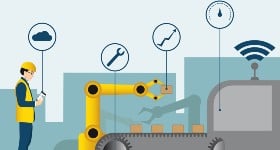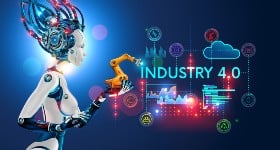NTT Data Services is an IT services provider and global innovation partner headquartered in Plano, Texas, with business operations in over 50 countries. Tanvir Khan, president of Business Process Outsourcing at NTT DATA Services, has answered some of IoT Evolution’s questions about Robotic Automation.
IoT Evolution: Explain Robotic Process Automation. Does this eliminate people or is it more about improving processes people use?
Tanvir Khan: In simple terms, Robotic Process Automation (RPA) is a software approach to managing processes that are traditionally done by people (no, they’re not really robots). The early form of RPA included tasks that were rules-based and done by software scripts. Now, RPA includes higher cognitive skills and decision-making that previously could only be done by people. Cognitive technology can now help with processes that require human decision-making.
To further help define this, there are three components to cognitive technology. the components are: Natural language processing, which is how computers understand human language; Machine learning, how computers reach conclusions based on experience without being explicitly programmed; and Artificial intelligence, which is when computers solve problems learning from their environment without human intervention.
As work becomes more complex, we need to focus our human talent on those tasks that require reasoning and empathy, while automating the easier tasks.
For example, think of how automation has transformed the auto industry. In 1909, it took 303 hours to make a car in 1929 it was 92 hours. Today, it takes 30 man-hours to make a car. And today’s cars are far more complex than the cars of 1925.
In 1925, eight million cars were produced worldwide, and last year the number of cars and light trucks produced topped 88 million. The ability to increasingly automate the processes in the auto industry is what made automobiles affordable for everyone. As additional automation was introduced, cars could be produced faster and at a dramatically lower cost. It’s now a massive industry because of the ability to automate.
So in short, yes some labor will decrease (with the simple tasks that can be automated) but there will be more opportunities for the labor force that will outweigh the perceived loss of jobs. You see this across multiple industries…the greater the disruption from automation, the greater the long term growth and job creation in that industry.
IoTE: Japan has been the adopter of Deming and other quality management strategies. Is this a machine-learned version of those concepts?
TK: RPA is simply an automated way of doing a manual process. Six Sigma and Deming apply as much to an automated process as to a manual process. Just as you can apply quality management and continuous improvement to human processes, you can apply those same strategies to RPA-driven processes. For example “Lean Bots” conduct time analysis on automated processes, eliminate NonValue Added (NVA) tasks, make configuration changes and optimize processes to bring continuous improvement to automated processes.
As we move to more cognitive intelligence, quality management is almost “built in.” Through machine learning, systems get smarter over time and the results continue to improve. And, of course, when bots have the ability to infer, we move closer to true artificial intelligence.
IoTE: How does NTT DATA Services work with customers to implement RPA?
TK: NTT DATA Services works with our clients to help them realize the benefits of automation. Cost savings and consistency of quality are the two most obvious areas where RPA can help. But two additional benefits – and where the real opportunities for improvement are – include peak load management and work clusters. Automated workers can take up the extra workload during peak times and smoothen turnaround time.
For example, a bank branch receives 10 customers per hour on any given day, but on paydays, there are 20 people waiting in line at the bank during lunch hour. This is a classic example of Peak Load. We all experience it, whether in a Starbucks line or listening to hold music with customer service call centers. When Peak Loads occur, we can’t magically add several more people to handle the peaks, but software robots (bots) can easily be scaled up or down. Imagine a day when a new barista appears every time there are more than 3 people in a Starbucks line.
We look at the client’s business problem, design, develop and deploy an RPA solution, and charge the customer for a business outcome. For example, if processing health insurance claims is taking an inordinate amount of time and costing an exorbitant amount of money for a health insurance company, we will deploy claim processing bots to adjudicate claims, crash the processing timelines and charge a unit price per claim for each claim successfully processed. All design, development and deployment is our investment, and we guarantee the business outcome.
IoTE: It strikes me that most call centers are very scripted and structured. Typically how does the use of RPA change the management of these jobs?
TK: A call center representative should identify and empathize with the customer who is calling in and provide the service they need. Real human interaction is necessary for important issues that customers may call in for. With intelligent agents, such as NLP IVRs, chatbots, and virtual agents, simple transaction tasks such as paying a bill, pulling up a statement, or finding an office can be automated. This will leave humans to do what humans do best: empathize, help and solve problems for the customers that need it most.
Edited by
Ken Briodagh





